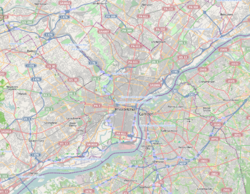Society Hill, Philadelphia, Pennsylvania
|
Society Hill Historic District
|
|
|
Head House Square, 400 block of S. 2nd St.
|
|
| Location | Bounded on the N by Walnut St., on the S by Lombard St., on the E by Front St., and on the W by 8th St., Philadelphia, Pennsylvania |
|---|---|
| Coordinates | 39°56′42″N 75°8′58″W / 39.94500°N 75.14944°WCoordinates: 39°56′42″N 75°8′58″W / 39.94500°N 75.14944°W |
| Area | 163 acres (66 ha) |
| Built | 18th- to early 19th-century, and later |
| Architect | multiple |
| Architectural style | Federal, Georgian, Greek Revival |
| NRHP Reference # | 71000065 |
| Significant dates | |
| Added to NRHP | June 23, 1971 |
| Designated PRHP | March 10, 1999 |
Society Hill is a historic neighborhood in Center City Philadelphia, Pennsylvania with a population of 6,215 as of the 2010 United States Census[update]. Settled in the early 1680s, Society Hill is one of the oldest residential neighborhoods in Philadelphia. After urban decay developed between the late 19th and early 20th centuries, an urban renewal program began in the 1950s, restoring the area and its many historic buildings. Society Hill has since become one of the most expensive neighborhoods with the highest average income and second highest real estate values in Philadelphia. Society Hill's historic colonial architecture, along with intelligent planning and restoration efforts, led the American Planning Association to designate it, in 2008[update], as one of the great American neighborhoods and a good example of sustainable urban living.
The neighborhood contains one of the largest concentrations of original 18th- and early 19th-century buildings in the United States. Society Hill is noted for its Franklin street lamps, brick sidewalks, cobblestone and Belgian block streets bordered by two- to four-story brick rowhouses in Federal and Georgian architecture, and public buildings in Greek Revival architecture such as the Merchants' Exchange Building and the Old Pine Street Church.
...
Wikipedia





